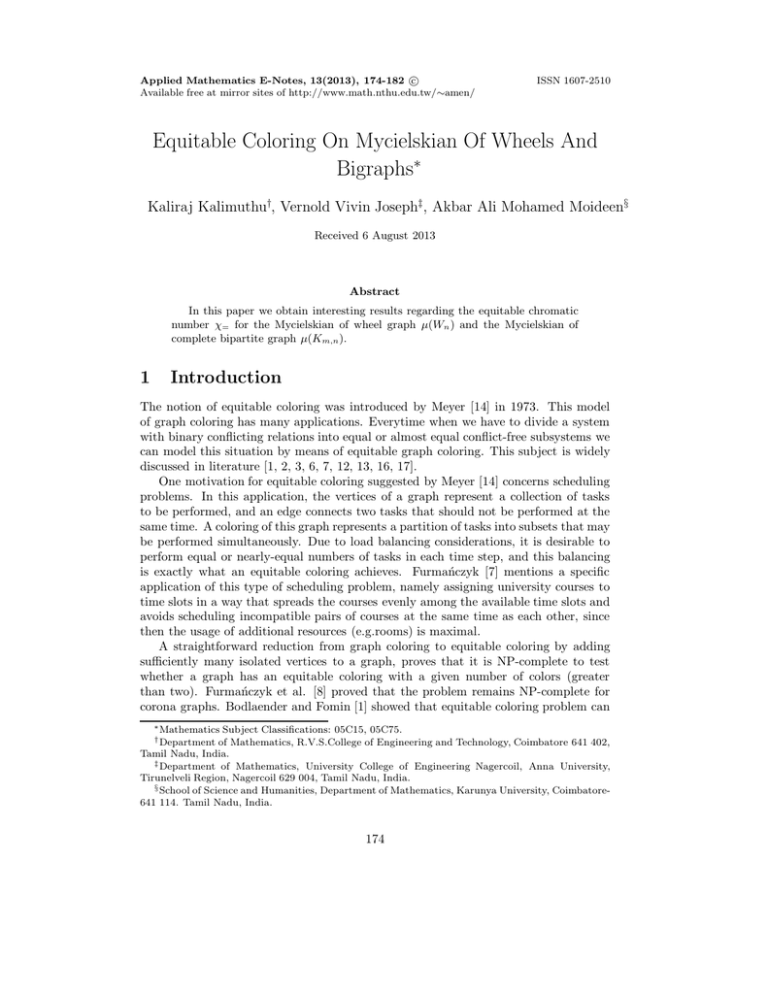Document 10677522
advertisement

c
Applied Mathematics E-Notes, 13(2013), 174-182 Available free at mirror sites of http://www.math.nthu.edu.tw/∼amen/
ISSN 1607-2510
Equitable Coloring On Mycielskian Of Wheels And
Bigraphs∗
Kaliraj Kalimuthu†, Vernold Vivin Joseph‡, Akbar Ali Mohamed Moideen§
Received 6 August 2013
Abstract
In this paper we obtain interesting results regarding the equitable chromatic
number χ= for the Mycielskian of wheel graph µ(Wn ) and the Mycielskian of
complete bipartite graph µ(Km,n ).
1
Introduction
The notion of equitable coloring was introduced by Meyer [14] in 1973. This model
of graph coloring has many applications. Everytime when we have to divide a system
with binary conflicting relations into equal or almost equal conflict-free subsystems we
can model this situation by means of equitable graph coloring. This subject is widely
discussed in literature [1, 2, 3, 6, 7, 12, 13, 16, 17].
One motivation for equitable coloring suggested by Meyer [14] concerns scheduling
problems. In this application, the vertices of a graph represent a collection of tasks
to be performed, and an edge connects two tasks that should not be performed at the
same time. A coloring of this graph represents a partition of tasks into subsets that may
be performed simultaneously. Due to load balancing considerations, it is desirable to
perform equal or nearly-equal numbers of tasks in each time step, and this balancing
is exactly what an equitable coloring achieves. Furmańczyk [7] mentions a specific
application of this type of scheduling problem, namely assigning university courses to
time slots in a way that spreads the courses evenly among the available time slots and
avoids scheduling incompatible pairs of courses at the same time as each other, since
then the usage of additional resources (e.g.rooms) is maximal.
A straightforward reduction from graph coloring to equitable coloring by adding
sufficiently many isolated vertices to a graph, proves that it is NP-complete to test
whether a graph has an equitable coloring with a given number of colors (greater
than two). Furmańczyk et al. [8] proved that the problem remains NP-complete for
corona graphs. Bodlaender and Fomin [1] showed that equitable coloring problem can
∗ Mathematics
Subject Classifications: 05C15, 05C75.
of Mathematics, R.V.S.College of Engineering and Technology, Coimbatore 641 402,
Tamil Nadu, India.
‡ Department of Mathematics, University College of Engineering Nagercoil, Anna University,
Tirunelveli Region, Nagercoil 629 004, Tamil Nadu, India.
§ School of Science and Humanities, Department of Mathematics, Karunya University, Coimbatore641 114. Tamil Nadu, India.
† Department
174
Kaliraj. K et. al
175
be solved to optimality in polynomial time for trees (previously known due to Chen
and Lih [3]) and outerplanar graphs. A polynomial time algorithm is also known for
equitable coloring of split graphs [2], cubic graphs [4] and some coronas [8].
In a search for triangle-free graphs with arbitrarily large chromatic numbers, Mycielski developed a graph transformation that transforms a graph G into a new graph
µ(G), we now call the Mycielskian of G, which has the same clique number as G and
whose chromatic number equals χ(G) + 1.
Mycielski [15] showed that χ(µ(G)) = χ(G) + 1 for any graph G and ω(µ(G)) =
ω(G) for any graph G with at least one edge. Besides such interesting properties
involving clique numbers and chromatic numbers, Mycielski’s graphs also have some
other parameters that behave in a predictable way. For example, it was shown by
Larsen et al. [11] that χf (µ(G)) = χf (G) + χf 1(G) for any graph G, where χf (G) is the
fractional chromatic number of G. Mycielski’s graphs were also used by Fisher [5] as
examples of optimal fractional colorings that have large denominators.
The problem of determining if χ= (G) = χ(G) or χ= (G) is ‘close to’ χ(G)−1 is hard
and has been extensively studied for general graphs. This paper presents a polynomial
time solution to the Mycielskian of wheel graphs and complete bipartite graphs.
2
Preliminaries
If the set of vertices of a graph G can be partitioned into k classes V1 , V2 , . . . , Vk such
that each Vi is an independent set and the condition ||Vi |−|Vj || ≤ 1 holds for every pair
(i, j), then G is said to be equitably k-colorable. The smallest integer k for which G is
equitably k-colorable is known as the equitable chromatic number of G and is denoted
by χ= (G).
The open neighborhood of a vertex v in a graph G, denoted by NG (v), is the set of
all vertices of G which are adjacent to v. Moreover, NG [v] = NG (v) ∪ {v} is called the
closed neighborhood of v in the graph G.
In this paper, by G we mean a connected graph. From a graph G, by Mycielski’s
construction [9, 10, 15], we get the Mycielskian µ(G) of G with V (µ (G)) = V ∪U ∪{z},
where
V = V (G) = {x1 , . . . , xn } , U = {y1 , . . . , yn }
and
E (µ (G)) = E (G) ∪ {yi x : x ∈ NG (xi ) ∪ {z} , i = 1, . . . , n} .
We have the following example of a Mycielskian construction of a complete bigraph
(Figure 1).
For any integer n ≥ 4, the wheel graph Wn is the n-vertex graph obtained by joining
a vertex v1 to each of the n − 1 vertices {w1 , w2 , . . . , wn−1} of the cycle graph Cn−1 .
For any set S of vertices of G, the induced subgraph hSi is the maximal subgraph
of G with vertex set S.
176
Equitable coloring on Mycielskian of wheels and bigraphs
Figure 1: The Mycielskian graph of complete bipartite graph K3,3
3
Equitable Coloring of Mycielskian of Wheel Graph
We have the following Theorem 1.
THEOREM 1. Let µ(Wn ) be the Mycielskian of wheel graph. Then
5,2n+1 for n = 4,
χ= (µ(Wn )) =
, for n ≥ 5.
3
PROOF. Let
V (Wn ) = {xi : 1 ≤ i ≤ n}
and
E(Wn ) = {x1 xi : 2 ≤ i ≤ n} ∪ {xi xi+1 : 2 ≤ i ≤ n − 1} ∪ {xn x2 } .
By Mycielski’s construction,
V (µ (Wn )) = V (Wn ) ∪ {yi : 1 ≤ i ≤ n} ∪ {z} .
In µ (Wn ), y1 is adjacent to each vertex of {xi : 2 ≤ i ≤ n}, each yi (2 ≤ i ≤ n) is adjacent to the set of vertices of N (xi ). z is adjacent to each vertex of {yi : 1 ≤ i ≤ n}.
1. n = 4
177
Kaliraj. K et. al
Since h{x1 , x2 , x3, x4 }i is K4 , each of these vertices receives distinct colors c1 , c2 ,
c3 , c4 respectively. The same colors can be used to color the vertices y1 , y2 , y3
and y4 in the same order. Since z is adjacent to each of y1 , y2 , y3 and y4 there
exists a new color to color z. Hence χ= (µ(Wn )) = 5 for n = 4.
2. n ≥ 5
By the definition of Mycielskian, x1 is adjacent to each of {xi : 2 ≤ i ≤ n} ∪
{yi : 2 ≤ i ≤ n}. There exists a color (say c1 ), which is assigned to x1 , so that it
cannot be assigned to any vertex of {xi : 2 ≤ i ≤ n} ∪ {yi : 2 ≤ i ≤ n}. The color
c1 can be assigned at most two times in µ (Wn ). By the definition of equitable
coloring, the number of vertices of µ(Wn ), receiving the same color, is either 2
.
or 3. Therefore χ= (µ (Wn )) ≥ 2n+1
3
We use the following partition to color the vertices of µ(Wn ) equitably in the
following subcases:
(a) n = 5
V1
=
{x1 , y1 } ,
V2
V3
V4
=
=
=
{x2 , x4 , z} ,
{x3 , y3 , x5 } ,
{y2 , y4 , y5 } .
V1
V2
V3
=
=
=
{x1 , y1 } ,
{x2 , x5 , y2 } ,
{x3 , y3 , y5 } ,
V4
V5
=
=
{x4 , y4 , y6 } ,
{x6 , z} .
V1
V2
V3
V4
=
=
=
=
{x1 , y1 } ,
{x2 , y2 , y6 } ,
{x3 , y3 , y7 } ,
{x4 , y4 } ,
V5
V6
=
=
{x5 , y5 , x7 } ,
{x6 , z} .
(b) n = 6
(c) n = 7
(d) n ≥ 8
V (µ (Wn )) = {xi : 1 ≤ i ≤ n} ∪ {yi : 1 ≤ i ≤ n} ∪ {z} .
We first partition this vertex set as follows:
V (µ (Wn )) = V 0 ∪ V 00
178
Equitable coloring on Mycielskian of wheels and bigraphs
where
V0 =
n
o
2n − 2
2n − 2
xi : 1 ≤ i ≤
∪ yi : 1 ≤ i ≤
∪ xd 2n+1 e , xn , z
3
3
3
and
2n + 4
2n + 1
≤ i ≤ n − 1 ∪ yi :
≤i≤n .
V = xi :
3
3
Clearly V 0 ∪V 00 = V and V 0 ∩ V 00 = ∅ with |V 0 | = 2 2n−2
+ 2 and |V 00 | =
3
+ 1.
2n − 2 2n+1
3
Now we partition V 0 into 2n+1
independent sets each containing two vertices
3
of V 0 as follows:
00
n
o
2n − 2
Vi = {xi , yi } 1 ≤ i ≤
and Vd 2n+1 e = xd 2n+1 e , xn , z .
3
3
3
Clearly
d 2n+1
e
3
[
Vi = V 0 and Vi ∪ Vj = ∅
i=1
for i 6= j and |Vi | = 2 for each i. Now we add the vertices of V 0 into the partition
of V 00 without violating the independence of each Vi ’s. Since each xi (2 ≤ i ≤ n)
is adjacent to y1 and each yi (2 ≤ i ≤ n) is adjacent to x1 , V1 cannot be altered.
Similarly Vd 2n+1 e cannot be altered. Since z is adjacent with each yi (1 ≤ i ≤ n).
3
Hence
|V 0 | = V2 ∪ V3 ∪ · · · ∪ Vd 2n−2 e
3
and
|V 00 | =
2n − 2
2n + 1
2n + 1
+1 ≤
− 2.
3
3
Also, V2 , V3 , . . . , Vd 2n−2 e can be altered by adding at most one vertex from V 00
3
in such a way that the resultant Vi ’s contain at most three vertices. Hence
||Vi | − |Vj || ≤ 1 for i 6= j and each Vi is an independent set. This partition
implies V (µ (Wn )) can
be colored equitably with at most 2n+1
colors. Hence
3
2n+1
χ= (µ(Wn )) =
for n ≥ 5.
3
This completes the proof of theorem 1.
4
Equitable Coloring of Mycielskian of Bipartite Graph
We have the following Theorem 2
179
Kaliraj. K et. al
THEOREM 2. Let µ(Km,n ) be the Mycielskian
3,
4,
χ= (µ(Km,n )) =
3,
l
m
m+n
min(m,n) ,
of bipartite graph. Then
if m = n ≤ 4,
if m = n ≥ 5,
if 2m = n,
otherwise.
PROOF. Let
V (µ(Km,n )) = {xi : 1 ≤ i ≤ m} ∪ {yi : 1 ≤ j ≤ n}
and
E(Km,n ) = ∪m
i=1 {eij = xi yj : 1 ≤ i ≤ n} .
By Mycielski’s construction,
V (µ (Km,n )) = V (Km,n ) ∪ {x0i : 1 ≤ i ≤ m} ∪ yj0 : 1 ≤ j ≤ n ∪ {z} .
1. m = n ≤ 4
Since h{xi : 1 ≤ i ≤ 4}i, h{yi : 1 ≤ i ≤ 4}i and h{yi0 : 1 ≤ i ≤ 4}i are totally disconnected, each of these subgraphs can be assigned with single color.
Assign the color c1 to each of {xi : 1 ≤ i ≤ 4}, c2 to each of {yi : 1 ≤ i ≤ 4} and
c3 to each of {yi0 : 1 ≤ i ≤ 4}. Assign c1 to x01 , c2 to z and c3 to x02 . By this
process of assigning color, each color is assigned exactly 4 times. To color the
remaining vertices x03 and x04 , we can use the colors c1 and c3 without affecting
the equitable condition. Hence χ= (µ(Km,n )) = 3 for m = n ≤ 4.
2. m = n ≥ 5
By applying the above said procedure to color equitably, we color each of {yi : 1 ≤ i ≤ n}∪
{z} by c2 . Hence the remaining number of vertices to be colored is 3n. These 3n
3n
vertices should be divided into two sets, each containing 3n
2 and
2 + 1 vertices.
6= n + 1and 3n
+ 1 6= n + 1for n ≥ 5, we conclude that the partition of
Since 3n
2
2
V (µ(Km,n ))into three sets satisfying ||Vi | − |Vj || ≤ 1for i 6= jis not possible and
hence χ= (µ (Km,n )) ≥ 4. We use the following partition to color the vertices of
µ(Km,n )for m = n ≥ 5equitable in the following:
V1
V2
=
=
{xi : 1 ≤ i ≤ n} ∪ {z} ,
{yi : 1 ≤ i ≤ n} ,
V3
V4
=
=
{x0i : 1 ≤ i ≤ n} ,
{yi0 : 1 ≤ i ≤ n} .
Clearly ||Vi | − |Vj || ≤ 1 for i 6= j. Hence χ= (µ(Km,n )) ≤ 4 and so
χ= (µ (Km,n )) = 4.
180
Equitable coloring on Mycielskian of wheels and bigraphs
3. 2m = n
Since there exists an odd cycle x1 y10 zx01 y1 x1 in µ (Km,n ),
χ= (µ(Km,n )) ≥ 3 for 2m = n,
V1
V2
V3
4.
= {xi , x0i : 1 ≤ i ≤ m} ,
= {yi : 1 ≤ i ≤ n} ∪ {z} ,
= {yi0 : 1 ≤ i ≤ n} .
Clearly ||Vi | − |Vj || ≤ 1 for i 6= j. Hence χ= (µ(Km,n )) ≤ 3 and so χ= (µ (Km,n )) =
3.
m
l
m+n
min(m,n)
|V (µ (Km,n ))| = 2m+2n+1 without loss of generality assume that m < n. Then
by the construction of equitable coloring, all the vertices of
X = {xi : 1 ≤ i ≤ m} ∪ {x0i : 1 ≤ i ≤ m}
receive the colors according to any one of the following cases:
(a) If X receives the same color 1. In this case the color 1, appears at the
maximum of 2m times. The other colors 2, 3, . . . are used
of
at the maximum
2m+1 times to color the vertices of {yj : 1 ≤ j ≤ n}∪ yj0 : 1 ≤ j ≤ n ∪{z}.
Therefore each color appear at most 2m + 1 times and at least 2m times.
(b) If X receives the same color 1 with an another color 3, then the color 1,
appears at the maximum of 2m − 1 times and other colors 2, 3, . . . are used
at
0 the maximum
of 2m times to color the vertices of {yj : 1 ≤ j ≤ n} ∪
yj : 1 ≤ j ≤ n ∪ {z}. Therefore in this case each color appear at most 2m
times and at least 2m − 1 times.
Therefore we conclude from the subcases (a) and (b) that the minimum
2m+2n+1num
or
ber
of
colors
to
be
used
to
get
equitable
coloring
of
µ
(K
)
is
either
m,n
2m
h
i
m+n 2m+2n+1
. (i.e.)
.
2m+1
l
mm
m+n
In general min(m,n)
.
l
m
m+n
colors,
In such a coloring, out of min(m,n)
l
m
2m+2n+1
m+n
(2m + 2n + 1) −
× min(m,n)
colors appear 2m+2n+1
+ 1 times and
m+n
m+n
d min(m,n) e
d min(m,n)
e
2m + 2n + 1
m+n
l
m +1 ×
− (2m + 2n + 1)
m+n
min (m, n)
min(m,n)
colors appear
2m+2n+1
d
e
the proof of theorem 2.
m+n
min(m,n)
times. Hence χ= (µ(Km,n )) =
l
m+n
min(m,n)
m
. This completes
Kaliraj. K et. al
5
181
Summary
This paper establishes an optimal polynomial time solution to the equitable chromatic
number of Mycielskian of wheels and bigraphs. A further study on equitable coloring
and Mycielskian graph families would result in some nice contributions to the literature
and applications in this area.
Acknowledgment. The authors sincerely thank the anonymous reviewer for
his/her careful reading, constructive comments and fruitful suggestions that have resulted in the improvement of the quality of this manuscript.
References
[1] H. L. Bodleander and F. V. Fomin, Equitable colorings of bounded treewidth
graphs, Theoret. Comput. Sci., 349(1)(2005), 22–30.
[2] B. L. Chen, M. T. Ko and K. W. Lih, Equitable and m-bounded coloring of
split graphs, in: Combinatorics and Computer Science (Brest, 1995) LCNS 1120,
Springer (1996), 1–5.
[3] B. L. Chen and K.W. Lih, Equitable coloring of trees, J. Combin. Theory Ser. B,
61(1994), 83–87.
[4] B. L. Chen, K.W. Lih and P.L. Wu, Equitable coloring and the maximum degree,
European J. Combin., 15(5)(1994), 443–447.
[5] D. C. Fisher, Fractional colorings with large denominators, J. Graph Theory,
20(1995), 403–409.
[6] H. Furmańczyk, Equitable coloring of graphs, in: Graph Colorings, (M. Kubale,
ed.) American Mathematical Society Providence, Rhode Island (2004).
[7] H. Furmańczyk, Equitable coloring of graph products, Opuscula Math.,
26(1)(2006), 31–44.
[8] H. Furmańczyk, K. Kaliraj, M. Kubale and V. J. Vernold, Equitable coloring of
corona products of graphs, Adv. Appl. Discrete Math., 11(2)(2013), 103–120.
[9] G. J. Chang, L. Huang and X. Zhu, Circular chromatic numbers of Mycielski’s
graphs, Discrete Math., 205(1–3)(1999), 23–37.
[10] J. Miškuf, R. Škrekovski, and M. Tancer, Backbone Colorings and generalized
Mycielski Graphs, SIAM J. Discrete Math., 23(2)(2009), 1063–1070.
[11] M. Larsen, J. Propp and D. Ullman, The fractional chromatic number of Mycielski’s graphs, J. Graph Theory, 19(1995), 411–416.
[12] K. W. Lih and P. L. Wu, On equitable coloring of bipartite graphs, Discrete Math.,
151(1–3)(1996), 155–160.
182
Equitable coloring on Mycielskian of wheels and bigraphs
[13] W. H. Lin and G. J. Chang, Equitable colorings of Cartesian products of graphs,
Discrete Appl. Math., 160(2012), 239–247.
[14] W. Meyer, Equitable coloring, Amer. Math. Monthly, 80(1973), 920–922.
[15] J. Mycielski, Sur le coloriage des graphes, Colloq. Math., 3(1955), 161–162.
[16] W. Wang and K. Zhang, Equitable colorings of line graphs and complete r-partite
graphs, Systems Sci. Math. Sci., 13(2)(2000), 190–194.
[17] H. P. Yap and Y. Zhang, Equitable colourings of planar graphs, J. Combin. Math.
Combin. Comput., 27(1998), 97–105.





